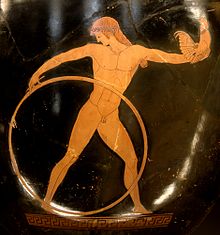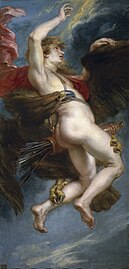Ganymede (mythology)

( Red-figure bell crater , traditional pederast gift , around 500 BC, Louvre in Paris)
Ganymed , also Ganymedes ( Greek Γανυμήδης [Ganymếdês] "the glorious", Roman : Catamitus ), is in Greek mythology a son of the Trojan king Tros and Kallirrhoë , brother of Assarakos and Ilos , and the "most beautiful of all mortals". He was loved by Zeus .
myth
As a shepherd boy he was kidnapped by Zeus to Mount Olympus so that he would be cupbearer for the gods and live there forever. In this task he replaced Hebe , the daughter of Zeus and Hera , against Hera's will. In another version, Eos is said to have kidnapped Ganymede, Zeus took him away from her.
The Ganymede legend was represented differently in antiquity: The oldest form was probably the Sumerian Etana myth. This myth is also depicted on panel 7 of the Epic of Gilgamesh . This speaks for the extremely old age of the myth. Other versions can be in the Iliad of Homer , but also in Virgil and Ovid , as well as Lucian found. In one representation Ganymede is kidnapped by a storm, in another version by Zeus himself, who has turned into an eagle , from Mount Ida in Phrygia to Mount Olympus .
According to a tradition, the shape of the eagle and Ganymede were transferred to the sky as constellations by Zeus, Ganymede as the zodiac sign Aquarius .
Interpretations
In Plato the myth of Zeus and Ganymede is presented as an invention of the Cretans. The example of Zeus was supposed to legitimize the love between men that was widespread among them. The legend gained great popularity in ancient Greece and in the Roman Empire , because it gave the passionate love of adult men for boys ( ephebophilia ) a religious justification. Xenophon sees in him the proof that it is not the physical, but the spiritual advantages that win the love of the gods. It is found on Roman sarcophagi as a symbol of the elevation of the human soul above the earthly.
In iconography , Ganymede is sometimes used as the prefiguration of John .
Representation in art
Antique images of Ganymede can be found on vases and other ornaments and utensils from the 5th century BC. Ganymedes is also a character in the Satyricon by the Roman author Titus Petronius .
In modern times , the (homo-) erotic meaning of the story has inspired many artists, including a drawing by Michelangelo , paintings by Rubens and Rembrandt , a marble sculpture by Thorvaldsen , a relief by Ferdinand Schlöth , a poem by Goethe and a Poem by Holderlin . Goethe's poem was set to music by Franz Schubert .
- Ganymede Representations in Art
Group of Zeus with Ganymede . 5th century BC BC Olympia Archaeological Park
The kidnapping of Ganymede ( Correggio ) around 1530, Kunsthistorisches Museum , Vienna
The Rape of Ganymedes
Rubens portrays Ganymede as a beautiful youth ...
1636–1638, Museo del Prado , MadridGanymede in the clutches of the eagle
… Rembrandt , on the other hand, was commissioned by a Dutch Calvinist patron as a scared, howling and urinating toddler.
1635, Old Masters Picture Gallery , DresdenGanymede , watering the eagle of Zeus
(marble group by Bertel Thorvaldsen )
1817, Thorvaldsen Museum , CopenhagenGanymed statue by Hermann Hubacher , 1952, on Lake Zurich in Zurich
Ganymede as namesake
- Because of Ganymede's function on Mount Olympus, comparable servants such as slaves, servants or waiters were sometimes referred to as Ganymedes in modern times .
- A moon of Jupiter, which was discovered by Galileo Galilei , is named after Ganymede ( → Ganymed (moon) ).
- Also a near-Earth asteroid of the Cupid type (→ (1036) Ganymede )
Individual evidence
- ↑ Libraries of Apollodorus 3, 12, 2
- ↑ Homer, Iliad 5,265-267 and 20,215-235
- ↑ Virgil , Aeneid 5.252 to 260
- ↑ Ovid , Metamorphoses 10.155-161
- ↑ Lukian of Samosata , Talks with the Gods 4 ( "Zeus and Ganymed") , 5 (" Hera and Zeus")
- ↑ Homeric Hymn 5 (To Aphrodite ), 202-208
- ↑ Ovid, Metamorphoses 10, 155–161; Lukian of Samosata, Talks with the Gods 4 and 5; Nonnos , Dionysiaka 281-282
- ^ Hyginus , Fabulae 224
- ^ Plato, Nomoi 636 c – e
- ↑ Robert von Ranke-Graves , Greek Mythology , Chapter 29. Rowohlt-Verlag, Reinbek near Hamburg, 2007.
- ↑ Xenophon, Symposium 8.30
- ^ Ganymede with eagle, marble relief, 1873, Sculpture Hall Basel (Depositium Gottfried Keller Foundation ); see. Stefan Hess , Tomas Lochman (ed.): Classical beauty and patriotic heroism. The Basel sculptor Ferdinand Schlöth (1818–1891), catalog for the exhibition of the same name in the Basel Sculpture Hall. Basel 2004, ISBN 3-905057-20-4 , p. 62, no. 68.
- ^ Johann Wolfgang von Goethe , Ganymed , Goethe's writings eighth volume, GJ Göschen. Leipzig 1774.
- ↑ Friedrich Hölderlin , “Ganymed”, Friedrich Hölderlin: Critical text edition. Volumes 2-6, 9-15. Luchterhand, Darmstadt 1979–1988.
- ^ Franz Schubert , Ganymed , D.544 (Op.19 No.3), 1817.
literature
- Wilhelm Drexler : Ganymedes . In: Wilhelm Heinrich Roscher (Hrsg.): Detailed lexicon of Greek and Roman mythology . Volume 1,2, Leipzig 1890, Sp. 1595-1603 ( digitized version ).
- Anette Kruszinsky: The Ganymed myth in emblematics and mythographic literature of the 16th century (= manuscripts for art history in the Werner publishing company 3). Wernersche Verlagsgesellschaft, Worms 1985, ISBN 978-3-88462-902-4
- Brigitte Sölch: Ganymedes. In: Maria Moog-Grünewald (Ed.): Mythenrezeption. The ancient mythology in literature, music and art from the beginnings to the present (= Der Neue Pauly . Supplements. Volume 5). Metzler, Stuttgart / Weimar 2008, ISBN 978-3-476-02032-1 , pp. 292-296.
Web links
- approx. 200 photos of depictions of Ganymede in art in the Warburg Institute Iconographic Database





